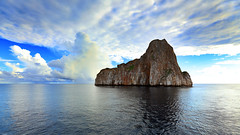I’ve been adding a lot of music to my digital collection recently, both by buying some stuff and ripping CDs I own. And so I run into the same old problems with the way iTunes sorts music. Actually it’s even worse on an iPod, because there’s no fancy GUI that you can customise with different columns and views and stuff. You’re stuck with selecting your songs by artist, by album name, or by composer. The problem is if I select by artist, part of the “B”s looks like:
- Mike Batt
- The Beatles
- Bee Gees
- Jodi Benson
- Berliner Philharmoniker
Okay, The Beatles and Bee Gees make sense. However, Berliner Philharmoniker is a symphony orchestra. The two albums performed by them that I currently have on my iPod are Holst’s “The Planets” and Beethoven’s 9th Symphony. I also have some Beethoven performed by other orchestras. However, the name “Beethoven” is not on my artist list, because he’s a composer, not a performer! If I want to find Beethoven stuff on this list, I need to look up all the different orchestras that perform his work. And each different orchestra has an unrelated bunch of works by different composers.
Who are Mike Batt and Jodi Benson, I hear you ask? (Okay, some of you probably know already.) Mike Batt composed the stage musical version of The Hunting of the Snark, based on Lewis Carroll’s poem. It was recorded by several artists, and Batt himself performs one song on the album. The rest of the album is scattered amongst several other artists’ names on the iPod artist list. Jodi Benson is the voice of Ariel, The Little Mermaid, who performs two songs on the movie soundtrack album. Again, the other songs on the album are scattered through the artist list.
So, on a quest to find all my Beethoven in one convenient location, I switch to selecting by composer, where the “B”s look a bit like this:
- Mike Batt
- Garry Beers, Tony Bruno, The Matrix, & Shelly Peiken
- Garry Beers, Andrew Farris, & Michael Hutchence
- Ludwig van Beethoven
- Chuck Berry
- Berry, Buck, Mills, & Stipe
- Berry & Willis
There are about a bazillion composers in this list. Sometimes a rock album will have songs by a dozen different composers! Beethoven is there, but he’s surrounded by thousands of composers I don’t care about, most of whom have one songwriting credit on some rock album. That’s no good.
And how do I find the entire Hunting of the Snark or Little Mermaid, should I wish to listen to the entire albums? I have to switch to a third view, the albums view. This view is not so bad, it does list all the albums as whole items, but the albums by any given artist (or composer) are all split up.
The solution to this? Well, there doesn’t seem to be a good solution. There are web pages and blog posts and forum questions all over the net with people asking how to sort their music better in iTunes. And there are no good answers. One common trick is to move the composer of classical works into the “Artist” field, so you see Beethoven in there with The Beatles and Bee Gees. But then the actual artist has to be deleted, or moved into some other field. It seems nobody has come up with a decent solution to this problem.
I was lamenting this fact at work today, when Andrew suggested that iTunes needs a “Primary” field, which is the primary sorting field you want to use for each album. It can be a radio button that selects one of either the artist, the composer, or the album name. For most stuff it defaults to the artist; for music marked as “Classical” in genre, it defaults to the composer; while for compilations, musicals, and soundtracks, it defaults to the album name. Then you can have a list that uses the Primary field to index all your music, and you’ll end up with a list that looks like:
- The Beatles
- Bee Gees
- Ludwig van Beethoven
- The Hunting of the Snark
- The Little Mermaid
Ta da! All your music sorted into one list in a sensible way! You can find everything by the most likely name you want to use, and with no superfluous data cluttering up the list.
How about it, Apple?
 We have arrived in Peru for a couple of days in Lima before joining our next Intrepid tour. We were up and packed by 05:30, and then at Guayaquil Airport by about 06:00. The first thing we encountered was a gadget staffed by two men which they were using to encase people’s luggage in great reams of plastic wrap. A lady tried to push us towards it, and at first we thought it was some sort of security requirement. But the guy said it cost US$10 a bag, and it seemed to be optional, so we started to walk away towards the check-in desks. The woman urged us in Spanish again, this time miming rainfall, and we realised that the plastic was meant to protect bags from the rain that was pouring down outside. Given the chance that our bags might be exposed to that while in the care of the airline, we paid our $20 and had the bags encased in plastic. It was a good thing too, because when we collected them, the handles (the only exposed bit) were soaked, and I saw some obviously water-damaged bags on the baggage claim carousel in Lima.
We have arrived in Peru for a couple of days in Lima before joining our next Intrepid tour. We were up and packed by 05:30, and then at Guayaquil Airport by about 06:00. The first thing we encountered was a gadget staffed by two men which they were using to encase people’s luggage in great reams of plastic wrap. A lady tried to push us towards it, and at first we thought it was some sort of security requirement. But the guy said it cost US$10 a bag, and it seemed to be optional, so we started to walk away towards the check-in desks. The woman urged us in Spanish again, this time miming rainfall, and we realised that the plastic was meant to protect bags from the rain that was pouring down outside. Given the chance that our bags might be exposed to that while in the care of the airline, we paid our $20 and had the bags encased in plastic. It was a good thing too, because when we collected them, the handles (the only exposed bit) were soaked, and I saw some obviously water-damaged bags on the baggage claim carousel in Lima. 
 I watched “
I watched “







